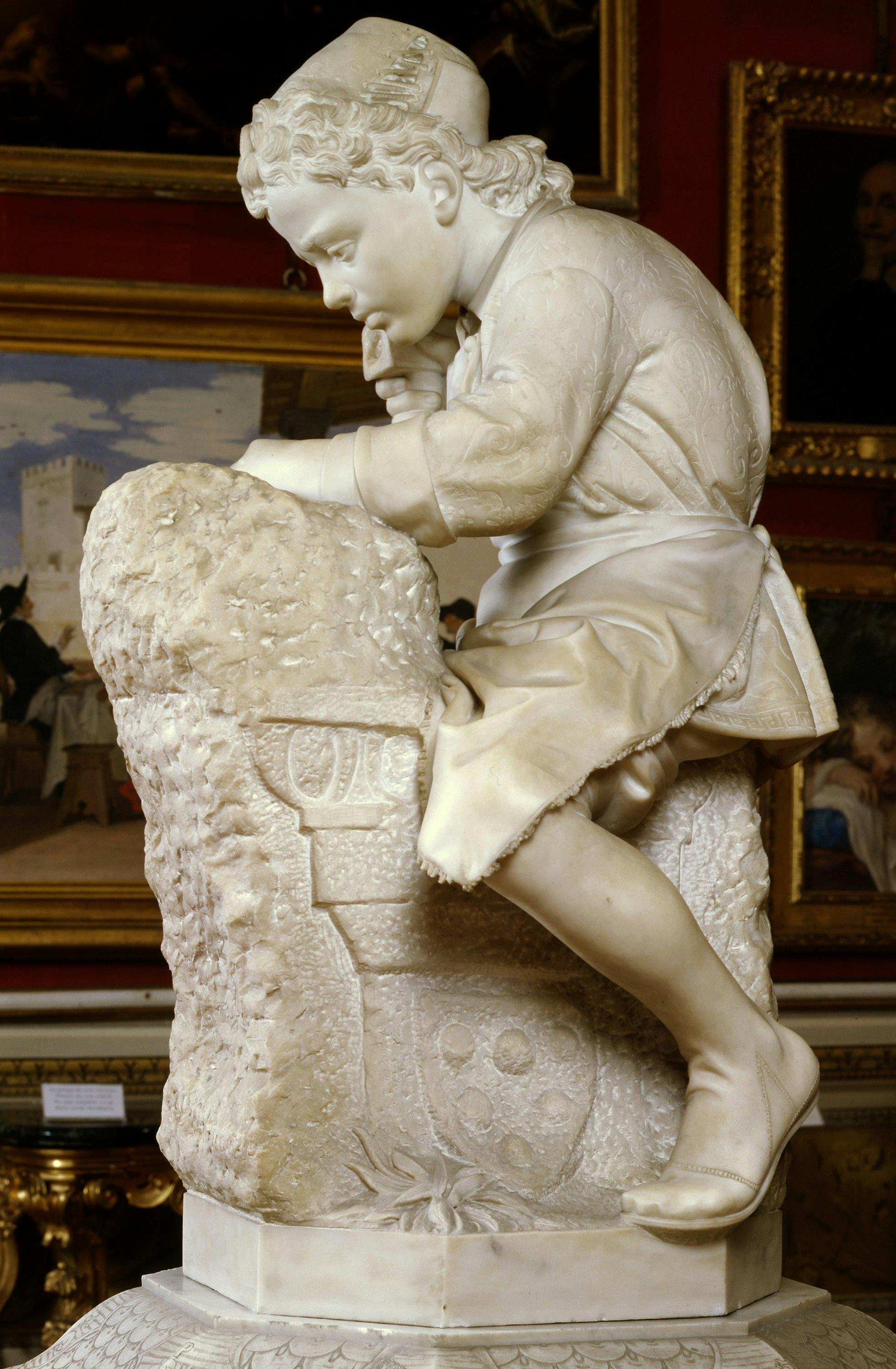Young Michelangelo
Emilio Zocchi (Florence, 1835 - 1913)
“ZOCCHI E. FIRENZE”
Made in Florence, this marble sculpture by Emilio Zocchi, a Florentine sculptor and pupil of Giovanni Dupré, depicts a very young Michelangelo Buonarroti (1475-1564) portrayed with chisel and hammer in the act of sculpting a faun's head already sketched out. The child sits on the remains of an ancient column, barely noticeable on the left side. The capital, embellished with pieces of vegetation and converted into an improvised work table by the young artist, alludes to the culture of antiquity whose study was central to Renaissance artists.
Zocchi, who first trained in the studios of private artists and later entered various Florentine academic circles, narrates a very significant episode in the life of Michelangelo Buonarroti, taken from Giorgio Vasari. He describes the meeting between Lorenzo di Piero de' Medici, known as Lorenzo the Magnificent, and Michelangelo.
This identification is helped by two elements: the first one is the shield with the six Medici spheres lying at Michelangelo's feet, on the left of the sculptural group; the second is the object being sculpted by Michelangelo, namely the head of a faun. Vasari recounts that Lorenzo the Magnificent, who was looking for young artistic talent for his school in the Giardino di San Marco, saw Michelangelo while engaged in “counterfeiting with a piece of marble the head of an old and wrinkled faun, whose nose was damaged and whose mouth was laughing.”
For the rendering of clothes and accessories that he depicted so accurately, Zocchi drew inspiration from paintings from the 15th and 16th century, which were widely studied and copied in the early 19th century. In sculpting the figure of Michelangelo, the artist focused on certain details of vivid realism that can only be appreciated on close inspection: the decorative motifs on the tunic, the leather apron, the folds of the shoes, and even the threads holding the cap together.
Such virtuosity impressed the visitors to Zocchi's atelier, including Victor Emmanuel II. The King was so amazed by the artist prowess that he bought the statue for his own apartments in the Pitti Palace in 1862. Indeed, this and other acquisitions made by the sovereign reflected the culture of historical romanticism that was flourishing in the national and international art scene, finding new useful ideas in the history of medieval and modern Europe to celebrate national history. In the case of Michelangelo, he was part of a specific current of artistic production in the second half of the 19th century, which aimed to celebrate the precocious genius of past masters through anecdotes from their childhood. Among the many examples, it’s enough to recall the story of the “young Giotto discovered by Cimabue”: a theme that inspired various artists of the time, including the Florentine painter Gaetano Sabatelli who painted Cimabue and Giotto (1846), which is also part of the Uffizi Gallery collections. There are, however, some critics who suppose that Zocchi with this work wanted to tell his own story, alluding to his first apprenticeship as an errand boy in his uncle's marble workshop, as recounted by biographer Angelo De Gubernatis (Angelo De Gubernatis, Dizionario degli artisti italiani viventi. Pittori, scultori, architetti, Firenze Gonnelli 1889, pp. 560-561).
There are several subsequent marble versions of the young Michelangelo sculpted by Emilio Zocchi (allegedly over a hundred) and there are also numerous pieces representing the same subject created by other sculptors, some of which were signed by his cousin Cesare. In 1865, Emilio participated with another of his replicas of the 'Michelangelo' to the International Exhibition in Dublin, where the work was also sold. In 1870, another version was exhibited at the Italian Exhibition of Fine Arts in Parma and, in 1873, at the Vienna Universal Exhibition, where the work was estimated at 5,500 lire.
C.Sisi, in K. Weil - G.Brandt - C. Acidini Luchinat - J.David Draper - N.Penny, La giovinezza di Michelangelo. Esposizione a Palazzo Vecchio e Casa Buonarroti, catalogo della mostra (Firenze, 6 ottobre 1999 - 9 gennaio 2000) Firenze, 1999, n. 81 p. 432; C.Sisi, Michelangelo nell’Ottocento, catalogo della mostra (Firenze, Museo di Casa Buonarroti 14 giugno – 7 novembre 1994) a cura di Stefano Corsi, Milano 1994, pp. 70-72; G.Gentilini, in Omaggio a Donatello (1386-1986). Donatello e la storia del museo, catalogo della mostra (Firenze, Museo del Bargello 19 dicembre 1985 – 30 maggio 1986) a cura di Paola Barocchi, Firenze,1985, pp. 428-429
